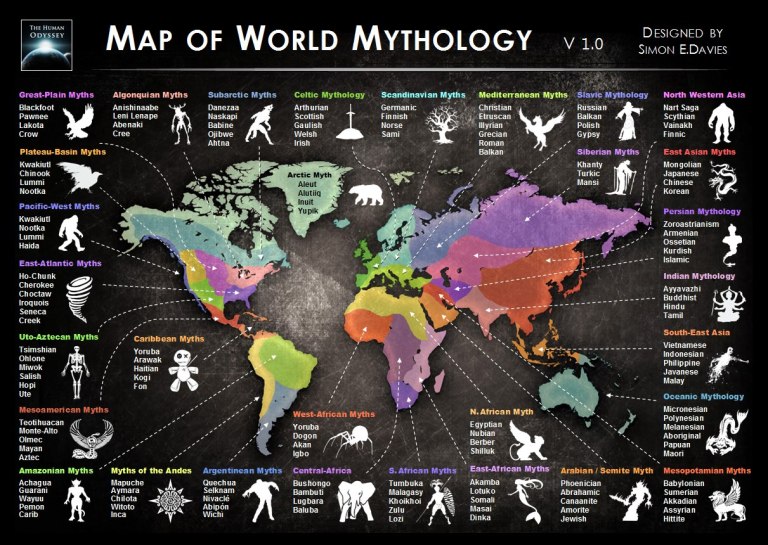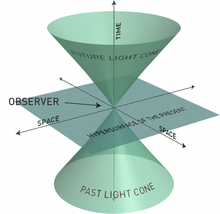
The Mythological Multiverse: Our happy epiphany
In 1800 William Hershel, the same astronomer who discovered the planet now lamentably known as Uranus, conducted a clever experiment to determine the correlation between different colors and temperatures. He first directed the sun's light through a prism, thereby separating it into its component colors. After placing two thermometers well away from the prism as controls, Herschel then measured the temperature of each color strip: Red, Orange, Yellow, Green, Blue, Indigo, Violet. He found that the lowest temperature corresponded to the violet and the highest to the red.*
On a whim, he decided to measure the region just slightly beyond the red: a place where no color was visible. Remarkably, he found that the temperature was highest there, the colorless area just "under the red." As Herschel discovered -and as the world would come to know- the Sun emits invisible, as well as visible, radiation. He referred to the unseen light as "infrared," or "below red." The following year, Johann Wilhelm Ritter noticed that the invisible radiation beyond violet caused a sheet of silver chloride to darken. He thereby discovered another form of invisible radiation now known as "ultra violet." Moreover, the visible light, which humanity had hitherto regarded as having encompassed the entirety of the electromagnetic spectrum, is now known to be merely a thin sliver within it. This realization only came about after some "epiphany moments" that do sometimes happen in science. Well, during the winter break, we,too, experienced something of an epiphany moment, albeit one that will have far less -i.e. negligible- effect on humanity: During our daily excursions into the rarefied mythological realms above, we have been traveling only through one wafer-thin layer of it; the layer inhabited by the likes of Apollo, Athena, Heracles, and Helen: those denizens of the Greek mythological Universe. These lofty characters are, themselves, part of a sub-genre known as Mediterreanean mythology, which also includes the closely related Roman and Etruscan mythologies. The image above shows that these chimerical universes are merely part of a much larger mythological matrix. It is much akin to the Milky Way Galaxy that diminishes into insignificance when regarded from a broad cosmological perspective.
Osiris

Brunhild
During the Exploratory Planetarium series, we, too, shall meander about the myriad ethereal layers to encounter the many entities populating the stupendously complex mythological multiverse: Beowulf to Brunhild to Brahma; Osiris to Orpheus to Osin. Greek mythology fans need not despair: we shall return to that layer many times during voyages. However, as is true with the physical cosmos, the mythological Universe is far grander in scope and larger in proportion than we can even begin to image: why not strive to explore every region within it?
We shall start to do so tomorrow.
*Wait a minute: Isn't violet higher energy than red? Why would violet be cooler than red? Well, as the light is refracted through the prism, the violet light is more diffuse and the red more concentrated. Even though violet light is more energetic, it is spread out more and so will register a lower temperature than the less diffuse red.**
**Wait a minute! Isn't the mythology section?!
THE SOUTHWORTH PLANETARIUM
207-780-4249 www.usm.maine.edu/planet
70 Falmouth Street Portland, Maine 04103
43.6667° N 70.2667° W
Altitude: 10 feet below sea level
Founded January 1970
Julian Date: 2459220.18
2020-2021: LXVI
THE DAILY ASTRONOMER
Wednesday, January 6, 2021
Exploratory Planetarium I: No Beginnings

"In an infinite Universe, every point in space-time is the center"
-David Zindell
We begin the "Exploratory Planetarium Series" by acknowledging that the beginning might well be as unknowable as the end. `The Planck Wall precludes any scrutiny of time's inception just as a lack of present understanding renders any scenario about the cosmic end uncertain. Despite the concerted efforts of thousands working meticulously over many years, the Universe remains soberingly mysterious. The visual parts -i.e. the stars, galaxies and clusters that emit detectable radiation- comprise perhaps 4 - 5 percent of the entire Universe. The remainder, dark matter and dark energy, are both enigmatic. Though theories abound, no explanations as to their natures are yet forthcoming. The Exploratory Planetarium will offer no explanations. Instead, as its name suggests, it will explore as many niches in the space-time matrix as time permits. (We intend to continue the Exploratory Planetarium until the Southworth Planetarium finally re-opens. In this instance, as in many others, the future remains exasperatingly opaque and so the date of our reopening is uncertain.)

In this vein, we will utilize the mind's supernatural capacities to travel to any point that we find interesting. Granted, our imaginary excursions prevent us from knowing everything about the given space-time segment we'll survey. Then again, most of what transpires around us each day goes unnoticed or remains unknown. Whereas the Remote Planetarium involved a direct progression from the night sky to the observable Universe, our trajectory will prove less linear. We could find ourselves around one of Jupiter's Trojan asteroids today and then we'd be milling about a star stream pulled away from the future Andromeda-Milly Way Galaxy collision tomorrow. The options are limitless and the cosmos is unbounded.
So, tomorrow we begin to explore a Universe with an unknowable beginning..or, perhaps, one that never had a true beginning to begin with...
To subscribe or unsubscribe from the Daily Astronomer: